

Margrit turned to fine art as a career, when she moved to the United States from Germany in 1995 and settled in Coconut Grove, Florida. It was at that time she began to explore many forms of artistic expression. She came in contact with more African art, while working in an African art and artifacts shop there. She had painted abstracts, while in Germany, but as her interest in Africa grew, she began to paint images of African people and their culture. She said, “I became fascinated by the beauty, strength and vitality of African people, whom I believe possess a symbolic force and a formal beauty.” Magrit says her art “embraces the poetry of African nuance and gesture and depicts the extraordinary diversity of their cultures.”She was further inspired to paint African portraits, after seeing photographs of African people in the books of two famous photographers, American, Angela Fisher and Australian, Carol Beckwith, who travel as a team and have photographed and documented sacred tribal ceremonies and tribal people across Africa. Margrit has also been influenced by photographs from Leni Riefenstahl’s book about Africa. She was a well known German film director, actress and dancer (1902-2003), and Margrit has painted portraits of Massai and Dinka people pictured in her book. Margrit’s abstract paintings also show influences of other artists, such as Klimt and Chagall.
Among the many other African tribes Margrit has painted portraits of are the Surma, a pastoral people, who live in southwestern Ethiopia. Because she became intrigued with the way they paint spectacular dotted patterns on their faces and bodies with white clay paint, they have become the subjects of many of her paintings, such as her painting of a young Surma girl, who caught her attention, “because of the mischievous expression on her painted face.”The dotted paint patterns are inspired by the spotted guinea fowl.
Margrit uses mixed media, including acrylic on canvas, watercolors and other media for her work. Her imaginative collages are created with a variety of materials, such as paint, paper, fabric, metallic material, tile and palm bark. She said she particularly likes to work with watercolor when doing African portraits because she likes, “the way the water flows and the colors.”
Discussing her inspiration and creative process, Margrit remarked that she does not plan any specific concept when painting collages, she said, “I love to listen to African music when I work. The music inspires me and ideas just come to me.”
In addition to her African portrait work, Margrit also paints commissioned portraits. Another aspect of her creativity is the construction unique wall cabinets, which she decoupages with colorful photos of antique carpets, and she also designs small decorative boxes with the use of decoupage and inlaid tile.
Margrit’s paintings which generally range in size from 11”x14” to 20”x 24” are available as both originals and giclees. Her paintings range in price from $300 to $2,800 for acrylics, and from $800 to $2,000 for watercolors.
Margrit also designs her own line of jewlery, using a wide variety of antique beads for necklaces, which she proudly notes, “are each uniquely designed.” She chose the name Zawadi, which means “gift” in Swahili, for her jewelry designs, “because every bead I use is a precious gift from ancient times.” Among the many interesting combinations of beads Margrit strings into her necklaces are Millefiori beads made by Venetian glass-makers between the fifteenth century and the nineteenth century, Czech and German glass beads from the early 1800s, copal amber beads from Mauritania, old Yemenite Silver Beads made by Jewish craftsmen, lost wax brass beads, batik bone beads, African Glass Beads, and Ethiopian Metal beads. Retail prices for her necklaces range from $155 to $300.
Margrit’s work has been exhibited at numerous galleries and art festivals in Florida and at the Yearly Art Show in the ICC in Berlin, Germany.
Now 60, Margrit continues to explore the cultural and artistic wonders of the Dark Continent, and she knows that, “African tribes will always continue to provide me with inspiration.”
For more information, visit:
www.africanartworkbymargrit.com
 |
|